Fast-food chain McDonald’s (NYSE:MCD) reported results in line with analysts' expectations in Q1 CY2024, with revenue up 4.6% year on year to $6.17 billion. It made a non-GAAP profit of $2.70 per share, improving from its profit of $2.63 per share in the same quarter last year.
McDonald's (MCD) Q1 CY2024 Highlights:
- Revenue: $6.17 billion vs analyst estimates of $6.17 billion (small beat)
- EPS (non-GAAP): $2.70 vs analyst expectations of $2.73 (small miss)
- Gross Margin (GAAP): 55.7%, in line with the same quarter last year
- Same-Store Sales were up 2% year on year
- Market Capitalization: $197.5 billion
Arguably one of the most iconic brands in the world, McDonald’s (NYSE:MCD) is a fast-food behemoth known for its convenience, value, and wide assortment of menu items.
The famous golden arches were first raised in 1940 by brothers Richard and Maurice McDonald. After achieving initial success at their flagship California location, the McDonald’s brothers were hungry for growth and reinvented their business in 1948 with the “Speedee Service System”, which used an assembly-line process to prepare food.
This invention laid the foundation for the fast-food concept we know today and enabled McDonald’s to deliver on its core value proposition of quick, affordable meals that don’t compromise on taste or quality. Since then, the company has evolved into the Zeitgeist of fast-food culture and expanded its menu to include not only burgers and french fries but also salads, wraps, breakfasts, and desserts.
The average McDonald’s store size varies, but most locations feature a counter for ordering, a seating area with a mix of booths and tables, and a drive-thru for added convenience. The layout is designed to serve both dine-in and takeout customers, with digital kiosks near the cash register to accommodate self-service customers who don’t want to wait in line.
The company has restaurants around the globe and is a leader in restaurant technology. It's not only built a popular mobile app but also has partnerships with leading delivery platforms such as DoorDash, Uber Eats, and Seamless (Grubhub) to meet consumers wherever they may be.
Traditional Fast Food
Traditional fast-food restaurants are renowned for their speed and convenience, boasting menus filled with familiar and budget-friendly items. Their reputations for on-the-go consumption make them favored destinations for individuals and families needing a quick meal. This class of restaurants, however, is fighting the perception that their meals are unhealthy and made with inferior ingredients, a battle that's especially relevant today given the consumers increasing focus on health and wellness.
Fast-food competitors include Burger King and Popeyes (owned by Restaurant Brands International, NYSE:QSR), Jack in the Box (NASDAQ:JACK), Taco Bell and KFC (owned by Yum! Brands, NYSE:YUM), and Wendy’s (NASDAQ:WEN).Sales Growth
McDonald's is one of the most widely recognized restaurant chains in the world and benefits from brand equity, giving it customer loyalty and more influence over purchasing decisions.
As you can see below, the company's annualized revenue growth rate of 4.3% over the last five years was weak, but to its credit, it opened new restaurants and grew sales at existing, established dining locations.
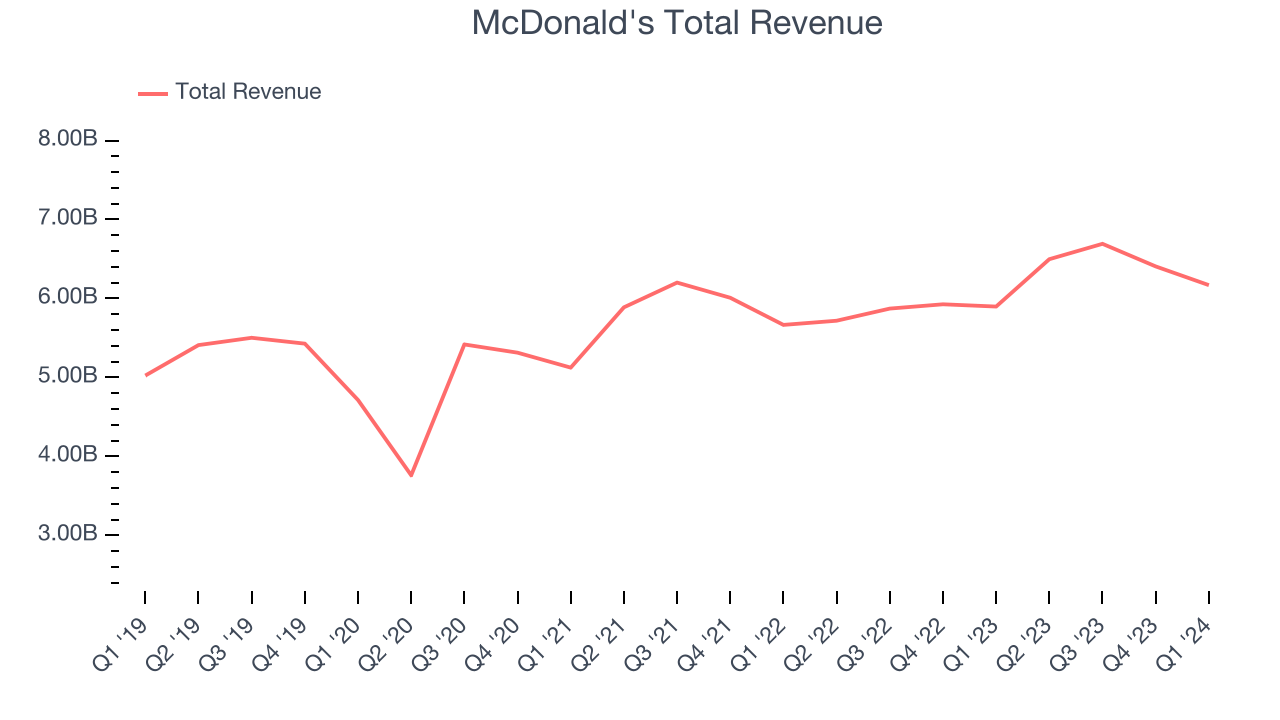
This quarter, McDonald's grew its revenue by 4.6% year on year, and its $6.17 billion in revenue was in line with Wall Street's estimates. Looking ahead, Wall Street expects sales to grow 5.6% over the next 12 months, an acceleration from this quarter.
Same-Store Sales
McDonald's demand has outpaced the broader restaurant sector over the last eight quarters. On average, the company has grown its same-store sales by a robust 8.8% year on year. With positive same-store sales growth amid an increasing number of restaurants, McDonald's is reaching more diners and growing sales.
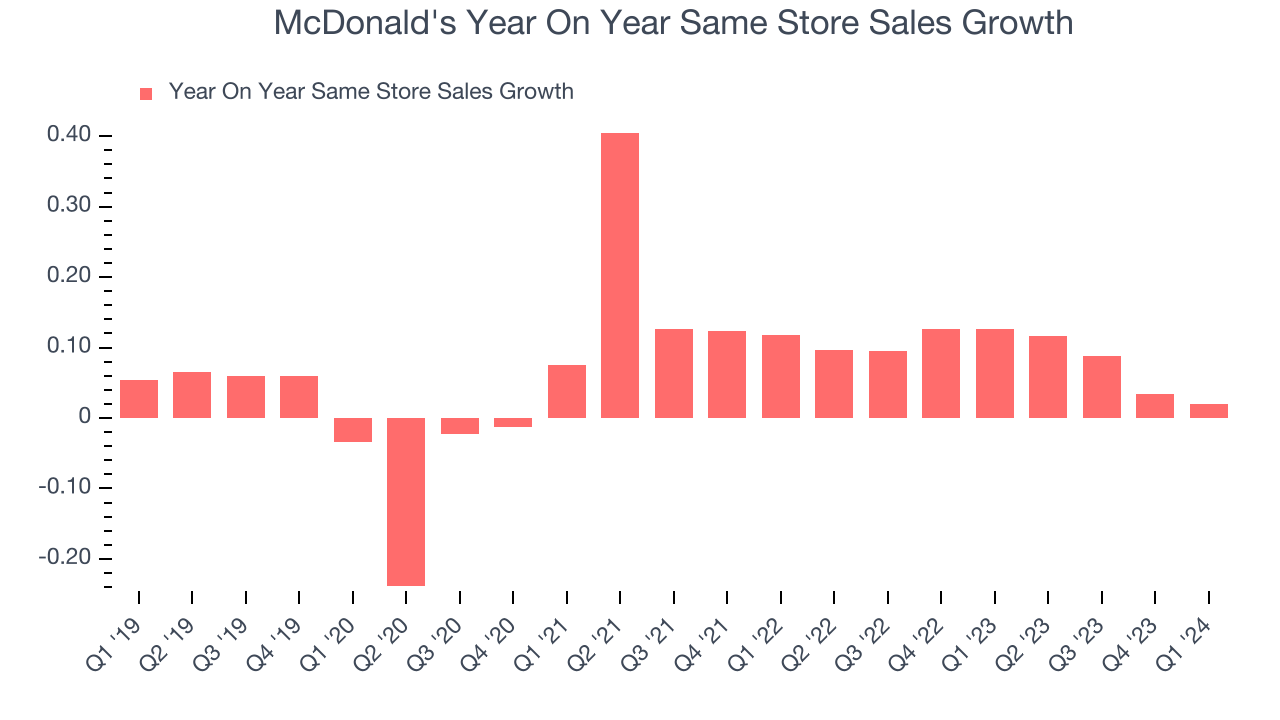
In the latest quarter, McDonald's same-store sales rose 2% year on year. By the company's standards, this growth was a meaningful deceleration from the 12.6% year-on-year increase it posted 12 months ago. We'll be watching McDonald's closely to see if it can reaccelerate growth.
Gross Margin & Pricing Power
In Q1, McDonald's gross profit margin was 55.7%. in line with the same quarter last year. This means the company makes $0.57 for every $1 in revenue before accounting for its operating expenses.
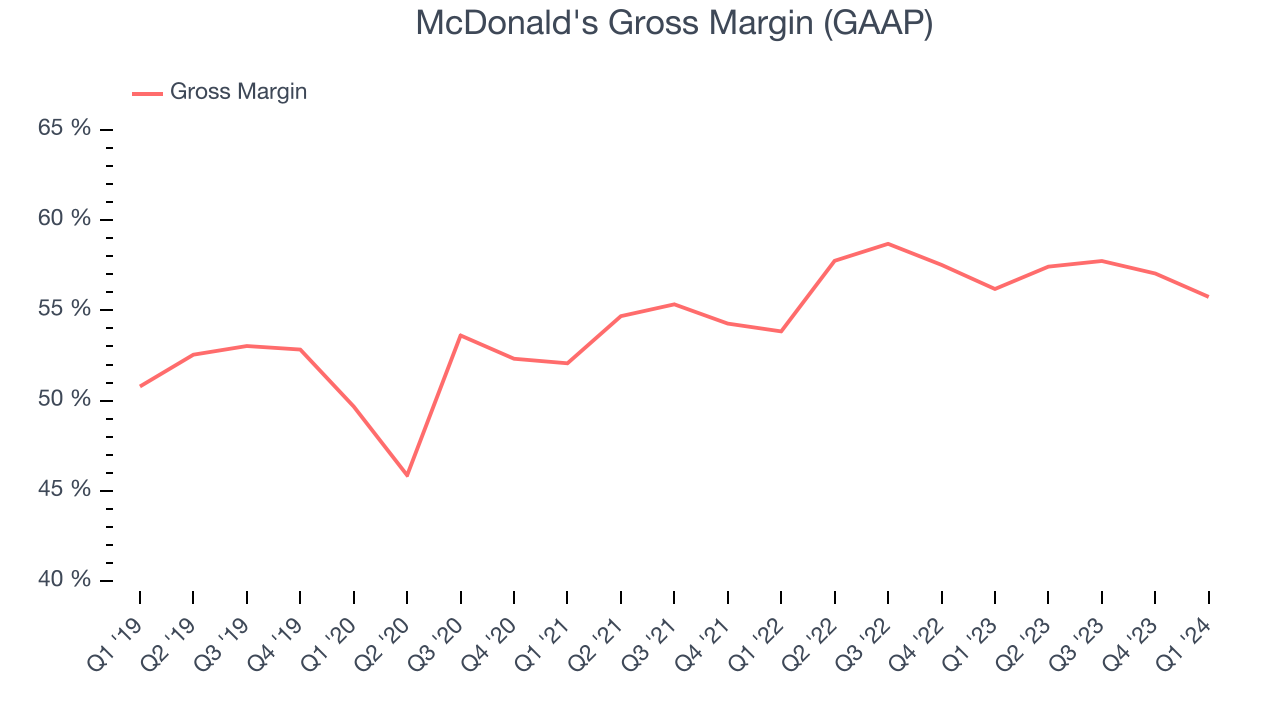
McDonald's has best-in-class unit economics for a restaurant company, enabling it to invest in areas such as marketing and talent to stay one step ahead of the competition. As you can see above, it's averaged an exceptional 57.3% gross margin over the last two years. Its margin has also been consistent over the last year, suggesting it has stable input costs (such as ingredients and transportation expenses).
Operating Margin
Operating margin is a key profitability metric for restaurants because it accounts for all expenses keeping the lights on, including wages, rent, advertising, and other administrative costs.
This quarter, McDonald's generated an operating profit margin of 44.4%, up 1.4 percentage points year on year. This increase was a welcome development and driven by some mixture of improved cost controls and leverage on fixed costs. Higher profitability is always a good thing.
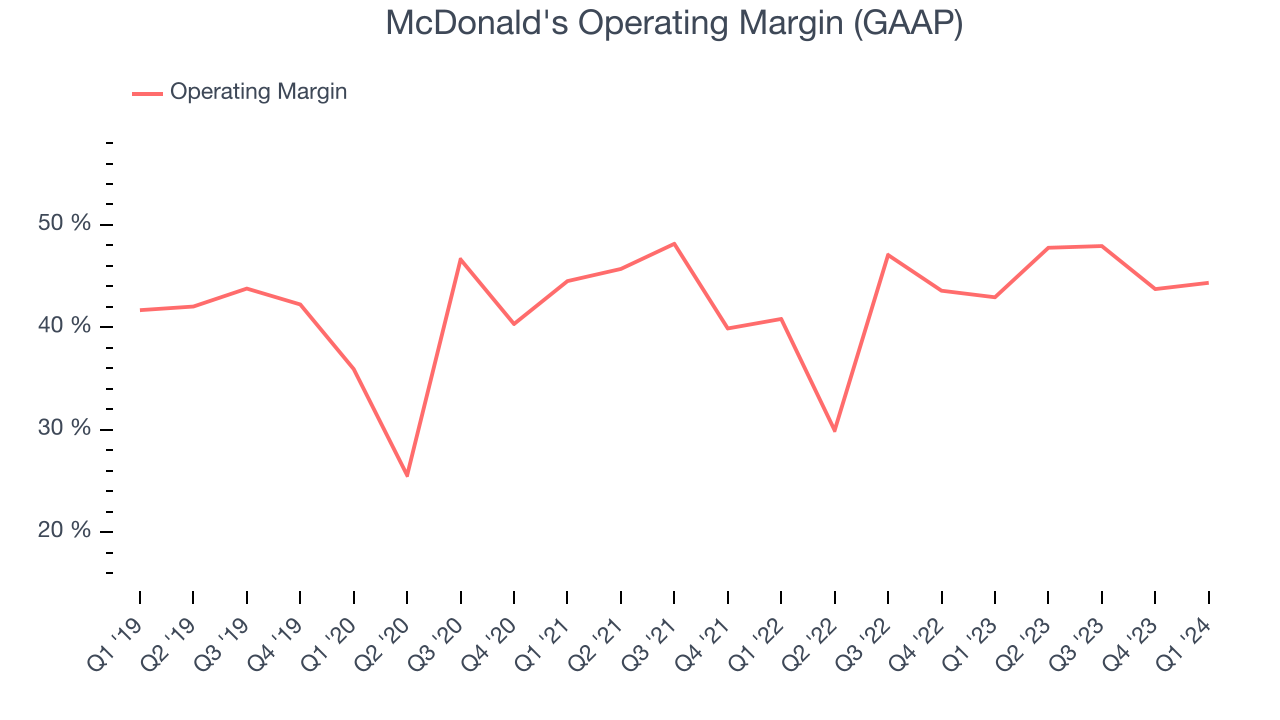 Zooming out, McDonald's has been a well-managed company over the last two years. It's demonstrated elite profitability for a restaurant business, boasting an average operating margin of 43.6%. On top of that, its margin has improved, on average, by 5 percentage points each year, a great sign for shareholders.
Zooming out, McDonald's has been a well-managed company over the last two years. It's demonstrated elite profitability for a restaurant business, boasting an average operating margin of 43.6%. On top of that, its margin has improved, on average, by 5 percentage points each year, a great sign for shareholders. EPS
These days, some companies issue new shares like there's no tomorrow. That's why we like to track earnings per share (EPS) because it accounts for shareholder dilution and share buybacks.
In Q1, McDonald's reported EPS at $2.70, up from $2.63 in the same quarter a year ago. This print unfortunately missed Wall Street's estimates, but we care more about long-term EPS growth rather than short-term movements.
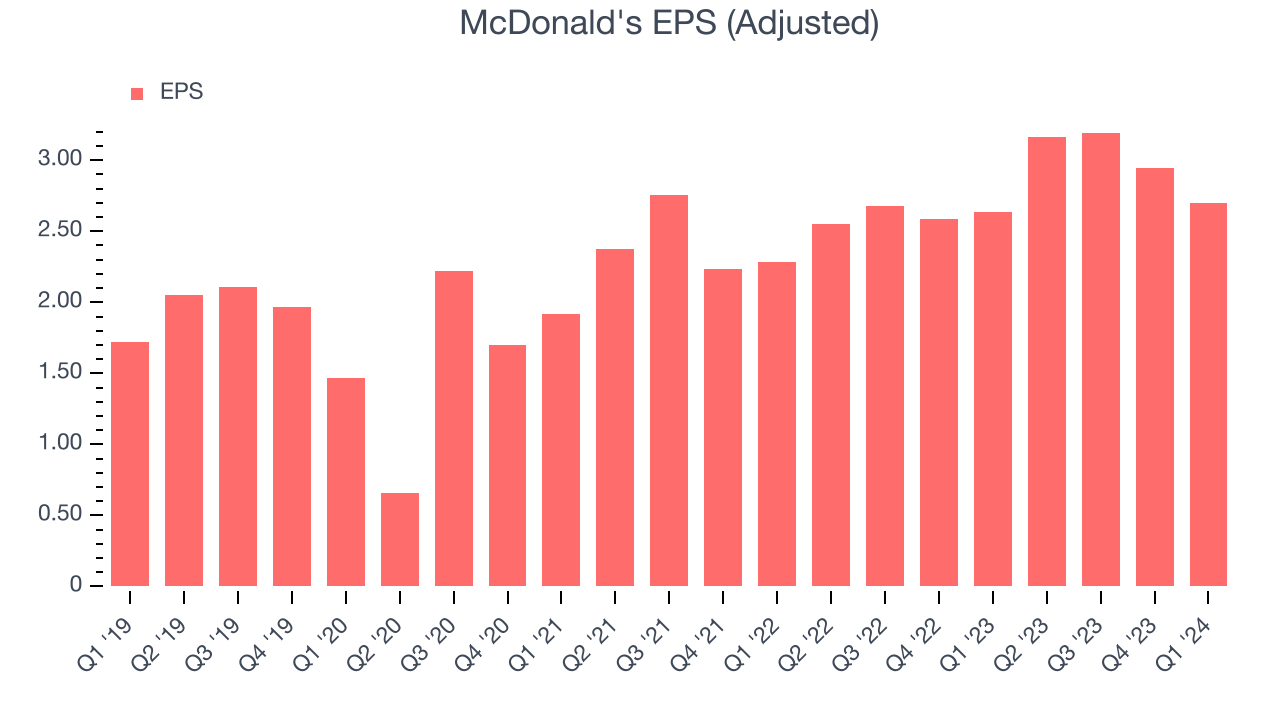
Wall Street expects the company to continue growing earnings over the next 12 months, with analysts projecting an average 5% year-on-year increase in EPS.
Return on Invested Capital (ROIC)
EPS and free cash flow tell us whether a company was profitable while growing revenue. But was it capital-efficient? A company’s ROIC explains this by showing how much operating profit a company makes compared to how much money the business raised (debt and equity).
McDonald's five-year average ROIC was 25.2%, placing it among the best restaurant companies. Just as you’d like your investment dollars to generate returns, McDonald's invested capital has produced excellent profits.

The trend in its ROIC, however, is often what surprises the market and drives the stock price. Over the last few years, McDonald's ROIC averaged 5.3 percentage point increases. The company has historically shown the ability to generate good returns, and its rising ROIC is a great sign. It could suggest its competitive advantage or profitable business opportunities are expanding.
Key Takeaways from McDonald's Q1 Results
This quarter was a par for McDonald's. Its revenue, same-store sales growth, and EPS were in line with analysts' expectations, showing the business is holding steady. Double-clicking into its three regions, we can see that same-store sales increased 2.5% and 2.7% in the U.S. and its International Operated Markets but shrank 0.2% in its International Developmental Licensed Markets. Overall, we think this was a decent quarter. The stock is flat after reporting and currently trades at $271.18 per share.
Is Now The Time?
McDonald's may have had a fine quarter, but investors should also consider its valuation and business qualities when assessing the investment opportunity.
We think McDonald's is a solid business. Although its revenue growth has been uninspiring over the last five years, its growth over the next 12 months is expected to be higher. And while its projected EPS for the next year is lacking, its impressive gross margins are a wonderful starting point for the overall profitability of the business. On top of that, its impressive operating margins show it has a highly efficient business model.
McDonald's price-to-earnings ratio based on the next 12 months is 21.7x. There are definitely things to like about McDonald's, and looking at the consumer landscape right now, it seems the company trades at a pretty interesting price.
Wall Street analysts covering the company had a one-year price target of $320.69 per share right before these results (compared to the current share price of $271.18), implying they saw upside in buying McDonald's in the short term.
To get the best start with StockStory, check out our most recent stock picks, and then sign up to our earnings alerts by adding companies to your watchlist here. We typically have the quarterly earnings results analyzed within seconds of the data being released, and especially for companies reporting pre-market, this often gives investors the chance to react to the results before the market has fully absorbed the information.
